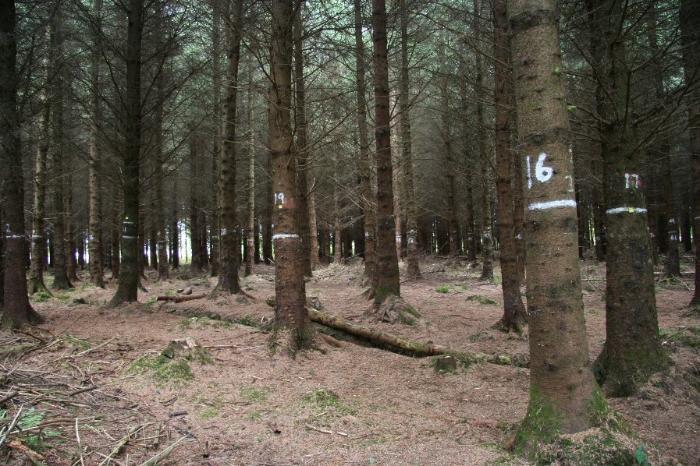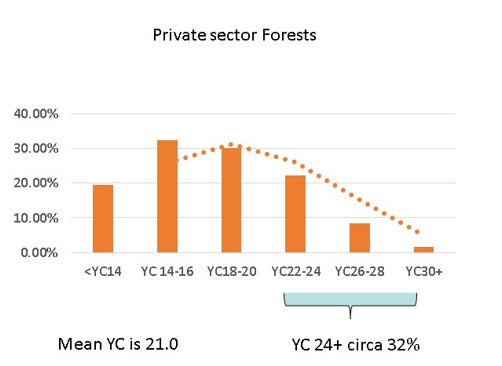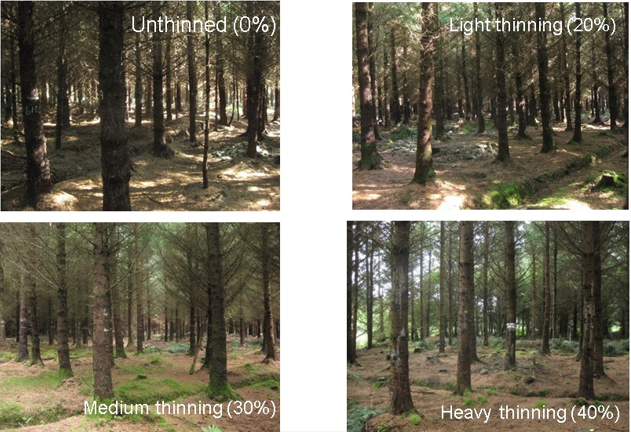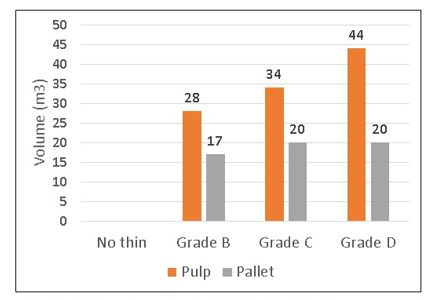15 November 2024
Part one: Thinning of high-yielding Sitka spruce – an overview and results

In part one of a two part series, Dr Niall Farrelly, Teagasc Forestry Development Department, discusses the importance of timely thinning practices for Sitka spruce.
There are over 140,000 hectares of Sitka spruce in private sector forests in Ireland. Performance is very positive, over 30% of forests are developing with high productivity (Figure 1). Best practice includes regular monitoring of forests and timely management, which often has to be planned earlier than envisioned. The wait and see approach won’t work for these plantations as these forests require timely interventions, including first thinning. In this, the first of a 2-part report Teagasc Researcher, Dr Niall Farrelly tells us more.

Figure 1: Positive Yield Class (YC) profile for privately owned Sitka spruce plantations in Ireland.
Yield class is an estimate of the productivity of your forest and is expressed in cubic metres per hectare per year (m3/ha/year). Forest example, a “Yield Class 21” forest is expected to yield an average of 21 m3/ha/year over its rotation.
When freshly harvested, 1.1 cubic metres (m3) of spruce wood is approximately equivalent to one tonne.
For forests with average yield classes of 18 to 20 m3/ha/year, first thinning, on suitable sites, can commence between 20 to 22 years of age, with the time required to grow trees suitable for commercial sawlog production (average tree size up to 0.8 m3) ranging from 40 to 44 years. For private forest exceeding these growth rates, earlier thinning is required, perhaps at 15 years of age, with the benefit of reduced time required to produce commercial sawlog products, occurring in some cases as early as 30 years (Table 1). In some cases, trees have reached this size in as little as 27 years of age. However this is only on suitable forests, with appropriate management as Teagasc research shows. While forest thinning is time critical, forest owners have the option of adjusting the timing of final harvest according to factors such as timber supply/demand, timber prices and other potential external drivers.
Table 1: A comparison in management and rotation length for average (YC 18-22) and productive plantations 9YC 24-30) in Ireland.
| Parameter | YC 18 -20 | YC 24-30 |
| Growth (15 years) | 8 m | 12 m |
| First thin age (12 m) | 20-22 | 15 |
| Rotation (years) | 40-44 | <30 |
| No of thinnings | 4 – 5 | 2-4 |
| Time to merchantable volume 0.8m3 (Years) | 40 | 30? |
| Profitability | €€ | €€€€ |
A recent field day in Frenchpark, Co. Roscommon in September demonstrated thinning practice in a yield class 24+ forest of Sitka spruce and demonstrated the benefits of timely thinning. Forest owners convened to see the results of over 14 years of Teagasc-funded research (Picture 1). The field day was aimed at supporting best practice development for productive Sitka spruce, many planted on productive mineral/wet mineral soils. Growers were taken through the range of management options on display which ranged from no thinning, to light, medium and heavier thinning options and some novel thinning systems.

Picture 1: Dr Niall Farrelly, Noel Kennedy and Liam Kelly give an overview of thinning highly productive Sitka spruce at the recent Frenchpark event in Co. Roscommon in September 2024.
This well-attended event was organised by the Teagasc forestry advisory and research team who provided growers with an overview of the benefits of thinning based on the experience over a 15 year research period. At the outset, Noel Kennedy, Forestry Advisor based in Boyle, stressed the importance of getting familiar with the forest, installing access paths and conducting a forest inventory to establish the growth pattern of the forest, its suitability for future thinning and timing of same. On suitably stable and highly productive forests, planning for the thinning operations should ideally take place as early as 12 years of age with preparation for the roading infrastructure and the securing of a felling licence. More information on harvesting and selling timber from Conifer Forests and is available here.
Dr. Niall Farrelly of Teagasc introduced growers to the research taking place on the site. Dr. Farrelly explained that Sitka spruce was our primary commercial species, accounting for over 80% of the harvested volume in Ireland. He added that, if possible, private growers should consider thinning and overall, an estimated 50% of private forests are considered suitable for thinning. Older foresters would be familiar with thinning plantations of yield class 18 to 20, which require later intervention, perhaps first thinning at 20 to 22 years of age with rotations of ~40 years. However, Dr Farrelly added that thinning practice has evolved to cater for the increases in productivity for private sites and current practice was to implement 3 thinnings followed by a final harvest somewhere around 30 years. Results of the research show that thinning at age 15, 20 and 25 years of age can result in the production of a merchantable log size in as little as 28 years, Dr Farrelly explained.
The aim of Teagasc research is to provide supports and guide growers through the approach to achieve this. While there is a lot of science behind the concept of sustainable yield – Dr Farrelly said that it is possible to break down the concepts into a readily understandable format. For example, he explained how the tree stocking levels, combined with the average diameter are the two most valuable pieces of information that can assist forest owners in preparing for thinning. For further details see the thinning ready reckoner. For fully stocked stands (>2000 stems per hectare) thinning should commence once the average diameter at breast height (i.e. diameter at 1.3 metres above ground level, referred to as “dbh”) is 16 cm.
An overview of the thinning operations conducted was presented, covering three thinning interventions. First thinning took place when the forest was 15 years of age, with 20 to 40% of the crop volume removed according to treatment, this can be equated to 50 to 70 m3 per ha. Every 7th line was removed systematically (removing 14% of the volume along the line) with a selection poorer quality trees between these lines also prioritised for removal. The recommendation was to focus the selection on removing dead, dying, supressed, crooked trees and wolf (big rough) trees at this stage between the lines.

Picture 2: the appearance of the different thinning treatments in Frenchpark after first thinning at age 15.
In Frenchpark, the number of stems removed in first thinning are presented in table 1. A light thinning operation would retain at least 1,500 stems per hectare of at least 17 cm in dbh. A medium thinning should retain about 1,250 stems per hectare of at least 17 cm and a heavy thinning should leave 1050 stems per hectare with a mean dbh of at least 18 cm. All thinning types should focus on increasing the residual average dbh by 1 to 2 cm by actively removing smaller stems. This will increase the dbh by at least 1.3 cm for medium thinning and by 2 cm for the heavy thinning treatment.
Table 1: Stocking table for Sitka spruce for each thinning type based on results from Frenchpark experiment.
|
Thinning Type |
Gross Volume/Ha removed
|
Stems/Ha before
|
Stems/Ha after |
DBH (cm) before |
DBH (cm) after |
Increase in Dbh (cm) |
Dbh removed (cm) |
|
Light thinning |
50 |
2199 |
1526 |
16.3 |
17.2 |
0.8 |
14.9 |
|
Medium thinning |
62 |
2069 |
1230 |
16.4 |
17.6 |
1.3 |
14.2 |
|
Heavy thinning |
73 |
2091 |
1049 |
16.2 |
18.5 |
2.3 |
13.6 |
|
No thinning |
0 |
2163 |
2163 |
16.2 |
16.2 |
0.0 |
|
The majority of the harvested trees removed at first thinning in Frenchpark produced pulpwood (suitable for panel boards and wood energy), with 30 to 38% of the harvested volume producing palletwood (e.g. for packaging, pallets and garden furniture), the higher proportions of pallet recoverable in heavy thinning.

Figure 2: The volume of pulpwood and palletwood produced at first thinning (in Net realisable volume) in Frenchpark for the three different thinning intensities, light thinning (grade B), medium thinning (grade C) and heavy thinning (grade D).
To summarise, first thinning should aim for an increase in dbh of the remaining crop of about 1 to 2 cm. The gross volume removed from first thinning should ideally be between 50 to 70 m3/ha, sufficient for producing 45 to 65 m3/ha of wood products. The products produced are predominately pulpwood with palletwood production comprising circa. 35% of the volume. Opportunity to avail of local markets for stakewood and biomass recovery might be locally applicable depending on location.
As each forest is different, it is strongly recommended that each forest is fully assessed as they approach thinning stage in terms of its suitability and timing. Teagasc forestry staff provide independent and objective advice to forest owners on all aspects of forestry including suitability for forest thinning and best practice in its implementation.
Next week, in part 2 of this series on best practice thinning for productive Sitka spruce, Dr Farrelly will discuss results from the second and subsequent thinning operations in Frenchpark.
